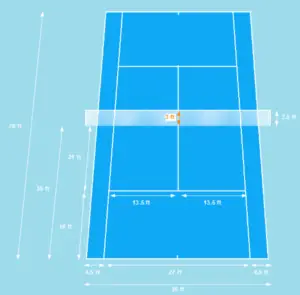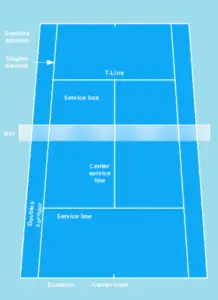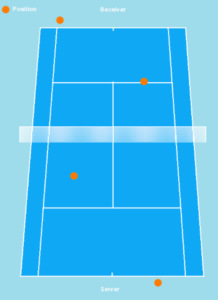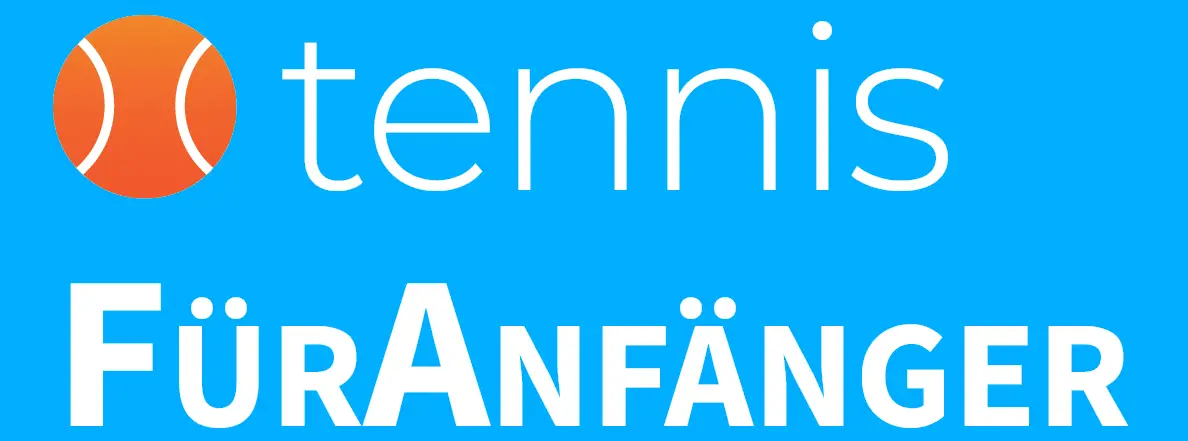Play tennis doubles
Learn how to play tennis doubles
Tennis is often perceived as a classic singles sport, but doubles is also becoming increasingly popular around the world. In most local competitions, both singles and doubles, two against two, are played to determine the winning team.
In doubles, different skills are needed to be successful compared to singles. In other words: Not every good singles player is a good doubles player, and vice versa.
How does a tennis doubles match work? What do I need to know about doubles? Below we give an introduction to doubles – enjoy reading.
1. Tennis doubles difference from singles
All tennis tournaments feature both singles and doubles competition. Overall, the media and spectators, and therefore most of the prize money, are focused on the singles players. Nevertheless, the doubles competition is just as hard fought as the singles and also offers top class tennis.
Besides the obvious difference of playing two against two instead of one against one, here are some other differences:
a) Own side selection
At the beginning of each doubles match, each pairing must clarify – assuming both are right- or left-handed – who will play on the forehand and who on the backhand side. Often a quick decision is made and the player with the better backhand plays on the backhand side.
However, statistically, because of the different conditions in doubles, more forehands are hit on the backhand side and more backhands are hit on the forehand side.
In addition, it should be noted that in the decisive advantage points are played on the backhand side. Therefore, if forehand and backhand strokes are comparable, the mentally stronger player should possibly prefer to play on the backhand side.
If one player is right-handed and the other left-handed, we recommend that both players play on the backhand side. Not only are more forehands played on the backhand side, but at the net you can both cover the frequently played middle with a forehand volley rather than a backhand volley.
As you can see, you should already go through some tactical considerations with your partner before the choice is made. But we can assure you: after each set played there is the possibility to change sides. However, most pairings stick to their original choice for the entire match.
b) Counting
For the classical tennis beginner rather not relevant, but on international level there is also a slightly adapted counting change in tennis doubles compared to singles: in case of deuce the next point decides the game win.
This was introduced to make doubles more attractive and exciting for spectators. Previously, many matches often went over deuce several times.
c) Order of service
During a service game, the server may not change. However, during the own service games within a set, the serving must always alternate between the playing partners.
After a finished set, the server can be determined again. Therefore, it is theoretically possible for a player to serve twice in a row. Normally, however, the serving side is retained throughout the entire match.
Also in the tiebreak, the other player will serve after each change of serve within the pairing.
d) Court size
The playing surface is larger compared to singles because the doubles corridors are added to the court. This increases the width of the tennis court by 4.5 feet on each side of the baseline. The length of the tennis court, however, remains the same.
The majority of tennis courts normally already have the double lines. These are only not taken into account for singles. For this, the so-called singles poles must be removed from the net, as the normal tennis poles are sufficient.
It is important to mention that the doubles corridors still do not count in the serve, but can only be played after the serve. The serve must therefore also be played into the service court in doubles.


e) Duration of the rallies
The duration of rallies is significantly shorter compared to singles. While in singles the game is usually dominated by the baseline, in doubles tennis the focus is on net play.
Good reaction skills are required, which lead to success at the net. Very solid volleys and good smashes are part of the standard repertoire of every doubles specialist.
2. Tennis doubles correct lineup
On your own serve, you are basically more forward and try to put pressure on the opponent’s doubles pair, e.g. by advancing to the net. In general, each player should cover one half of the court.
Compared to singles, the server is therefore classically positioned further out, so that the doubles corridor can also be covered after his own serve. With the serve, there is also the possibility to drive the opponent out of the court with a targeted angle.
The net player is classically located about halfway between the net and the T-line, covering his half of the court.
Both positions can of course be changed for different moves, but tennis beginners should first master these positions.
The first move should be briefly aligned for speed and direction before each rally.
i) Speed
With a fast first serve, for example, it is a good idea for the net player to move further to the net in order to volley an uncontrolled ball of the opponent at the net.
For a safe second serve, the net player should maintain a defensive position and cover his own half.
ii) Direction
On an outward serve, the net player moves further out to better cover the double corridor.
Similarly, when serving through the middle, the net player moves more toward the center of the court.

b) Opponent serve
The position of the return player in doubles is assumed to be approximately the same as in singles, since the service field has not changed.
The net player stands approximately on the T-line on the opponent’s first serve and moves forward on a good return and back on a bad return. Since a better return can be expected on a second serve, the net player immediately moves a little into the T-field.
3. Tennis doubles strategy and tactics
How do you actually play tennis doubles? Doubles strategy and tactics, along with excellent communication and blind understanding, are critical to doubles.
Before each own serve, the first move for the first and potential second serve is discussed. This includes the direction of serve:
a) serve to the outside
b) serve to the body
c) serve through the middle
the type of serve:
a) straight serve
b) slice serve
c) kick serve
and the paths after the serve:
a) server moves to the net, net player stays in position
b) server moves to the net and both change sides
c) the server stays behind and the net player stays in his position
d) Serve player stays behind and both change sides
Serving strategy is the key to success because some combinations are more efficient than other combinations. For example, on a slice serve to the outside, the server should not advance to the net and both players switch sides. The opposing player will play the return to the outside and would thus have a good opportunity to play the tennis ball longline into the open court.
It is also important to vary your serving strategy, otherwise your opponents will quickly adjust to your routines and respond better to your moves.
Since you will be positioned at the net at least half the time in doubles, be sure to practice volleys and smashes. The placement of your shots is more important than speed.
The net player is alert at all times and continuously covers his or her half of the court through skillful movements. In particular, watch the opposing net player, because when he changes sides and reaches the ball he will often play at you. If you turn around with the ball backwards to your own teammate and turn around with the shot forwards again, you have no chance to play back the ball of the incoming net player.
If, on the other hand, you should return, the shot between the opponents is often the best option. Because there the coordination of your opponents must be perfect. Tennis beginners in particular are usually not well-rehearsed, so you are sure to win easy points.
Normally, the player who plays the forehand in the middle will return the tennis ball. Because of the difficult coordination in the middle, when a left- and right-handed player play together, usually both play the forehand in the middle. A short “Me” call helps with the coordination and protects against possible collisions.
In general, it helps enormously to quickly identify the weaknesses of the opponent’s doubles pairing and to play them again and again, because a double is only as good as its weakest stroke.
4. Summary and conclusion
Tennis doubles is becoming more and more popular and offered in multiple tournaments. Therefore, doubles should be practiced regularly in training: well-rehearsed moves and harmonious communication between the playing partners is crucial for victories.
We wish you a lot of fun and success with your next doubles match.

